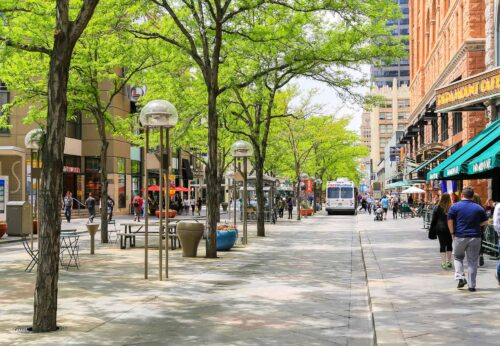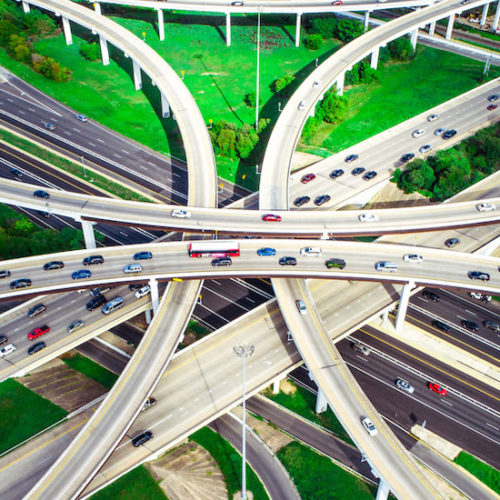
A Fork in the Road: States Will Determine the Future of US Transportation Pollution
How states spend federal infrastructure funding will either increase or decrease climate pollution from transportation — the choice is theirs.
Tailpipe pollution from cars and trucks accounted for 23 percent of the country’s climate pollution in 2019, and indirect emissions from fuel and vehicle production bring that up to almost 40 percent. The 2020 decline in driving (measured as vehicle miles traveled, or VMT) due to COVID-19 has not persisted. Simply put, the United States cannot meet its climate commitments without addressing transportation.
Of the three major recent federal laws supporting climate policy, the Infrastructure Investment and Jobs Act (IIJA) is most focused on transportation. However, the net effects of IIJA on transportation emissions will ultimately depend on investment decisions. How these funds are spent could help reduce transportation emissions, but they could also make the problem worse. And these investment decisions are largely up to states. State governments have broad flexibility to determine how both formula funding and grant funding are used, so they must carefully consider how they spend these funds to align projects with climate and other policy goals.
Early Spending Trends Are Not Good
RMI and Georgetown Climate Center (GCC) recently analyzed IIJA investment scenarios for 12 states, finding transportation investment decisions could potentially either increase road vehicle greenhouse gas emissions in states by 2 percent or reduce emissions by 3 percent after a decade (in 2032). If we extrapolate this to all 50 states and out to 2040, investment decisions could increase cumulative emissions by 170 million tons of carbon dioxide equivalent (MtCO2e) or decrease them by 440 MtCO2e.
Cumulative change in US road greenhouse gas emissions relative to baseline from 2022 to 2040 under three transportation investment scenarios for states under the IIJA
RMI Graphic. Data: RMI and GCC Analysis. Note that scenario names here have been modified from the published analysis. “TDM” is Transportation Demand Management.
RMI and GCC analyzed 30 investment strategies and identified several with the highest potential to reduce transportation emissions. Breaking with historical spending and avoiding highway capacity expansion was by far the most critical in limiting emissions. Unsurprisingly, investing in vehicle electrification, transit, and infrastructure for walking and biking would also reduce emissions.
However, so far, most states seem to be sticking with the counter-productive investment practices of the past several decades. Spending on roadway contracts in 2022 was nearly 30 times higher than spending on rail and transit contracts, while just 1 percent of IIJA funds are being put toward cycling and pedestrian infrastructure.
Vehicle electrification is critical for reducing transportation pollution — and it got a boost from the Inflation Reduction Act (the climate bill passed in 2022) — but it is not enough. Mid-range outcomes from the Inflation Reduction Act are only expected to increase new light-duty EV sales 10 percentage points by 2030, to 32 percent. Due to slow vehicle turnover (cars stay on the road, on average, for 17 years), these increased EV sales will translate to only 15 percent of the overall fleet of cars, SUVs, and pickups being electric by 2030. According to RMI analysis using the Energy Policy Simulator, even if every state copied California’s rule phasing out gas cars by 2035, only about 27 percent of the fleet would be electrified by 2032 — the year IIJA investments have maximal impact. And even 100 percent fleet electrification would not address indirect emissions. Thus, states cannot afford to backslide on VMT reduction by investing in new highway capacity.
The IIJA is just the tip of the transportation funding iceberg. For the 12 states RMI reviewed, it represents less than 26 percent of total anticipated transportation spending over the next decade. If we applied the same logic to the entire state transportation budget, assuming impacts are proportional to spending, the outcomes could range from about a 6 percent increase to a 9 percent decrease in 2032 road vehicle emissions — a 15 percent difference.
There are important caveats. Some of the individual strategies have saturation points: for example, there are only so many buses to be electrified in current transit fleets. Furthermore, the GCC Transportation Investment Strategy Tool quantifies investment strategies individually and does not consider synergies between complementary strategies. To reach the deep emissions reductions required for a safe climate future, states need to employ a whole-systems approach to maximize the benefits of investment dollars. State governments need to go beyond thinking about budgets and start thinking about reversing policies that encourage sprawl and its accompanying car-dependency.
The Need to Coordinate Investments with Land Use, Housing Policy, and Road Use Reforms
Beyond money and technology, a critical barrier to better transportation outcomes is simply how our policies prioritize the use of land and street space. Reforming costly car-centric policies could unlock private investment that increases government revenue and yields extensive economic, social, and environmental benefits.
A few examples illustrate the importance of public policy decisions shaping our use of developed space:
- An expensive new train will be scarcely used if its stations are placed in the middle of a highway or among acres of parking lots, whereas transit-oriented development could provide ample new riders.
- Replacing sparsely utilized buses that are stuck in traffic with new electric ones does not draw people out of cars, but converting mixed traffic lanes to dedicated bus lanes could more than pay off with speedier, more reliable, more efficient — and thus better utilized — transit.
- Funding e-bike rebates and bikeshare programs without providing protected bike lanes — or building a few disconnected segments rather than an integrated network — will leave out most potential riders. Instead, relatively small investments in high-quality bike infrastructure could lead to the surges in ridership that have been observed elsewhere in the world.
States have a key role in reforming land use to allow housing to be built near destinations, reducing travel distances, and making walking, biking, and transit more viable — and momentum is building. California scaled back burdensome parking mandates, streamlined conversion of underused commercial space to residential, and strengthened procedures requiring cities to plan for sufficient housing. Oregon, California, Connecticut, and Maine legalized small multifamily housing types such as accessory dwelling units and duplexes in most neighborhoods — though follow-on reforms may be needed to deliver results. Massachusetts required cities to allow transit-oriented development near Boston metropolitan area transit. Utah required cities to select from a menu of options for land use reform. Even more states are considering reform legislation or have governors calling for it, including Washington, Colorado, New York, and Montana.
City innovations during the COVID-19 crisis showed the potential for radically re-using urban street space. There has been some backsliding, but some changes are persisting. New York City, San Francisco, and other cities have kept their outdoor dining and Slow Streets programs. When the future of two new landmark car-free spaces in San Francisco was put to voters last November, they retained them by nearly a 2 to 1 margin. Meanwhile, Hoboken and Jersey City have surpassed most US cities in making “Vision Zero” (zero traffic deaths) a reality, even while road crash deaths surge nationwide. By encouraging shifts toward active transportation, these street changes can enhance safety while decreasing VMT and pollution.
In addition to wisely investing IIJA funds, state governments must support these reforms so they can scale. Most critically, they must remove barriers to the reprioritization of street space. For instance, states can move away from irrational “level of service” planning metrics toward ones that prioritize reducing VMT while enhancing people’s access to destinations; they can allow automated enforcement of dedicated bus lanes; and they can exempt inherently environmentally beneficial transportation projects from burdensome environmental review.
A Historic Opportunity
The IIJA funding now available for state governments could not have come at a more critical time: transportation emissions are not yet declining, threatening 2030 climate commitments. Transit systems are reeling from the pandemic and persisting remote work — which has had little impact on overall VMT but does threaten the revenue model of transit systems designed to serve suburban commuters. States must use transportation funding wisely: limiting road expansions and investing instead in EV infrastructure, public transit, and active transportation. Coupled with overdue reforms to land use, housing policy, and road use, states have the potential to not only bend the curve on transportation emissions but also achieve other vital policy goals, such as equity of access, safety, affordable housing, and public health.

